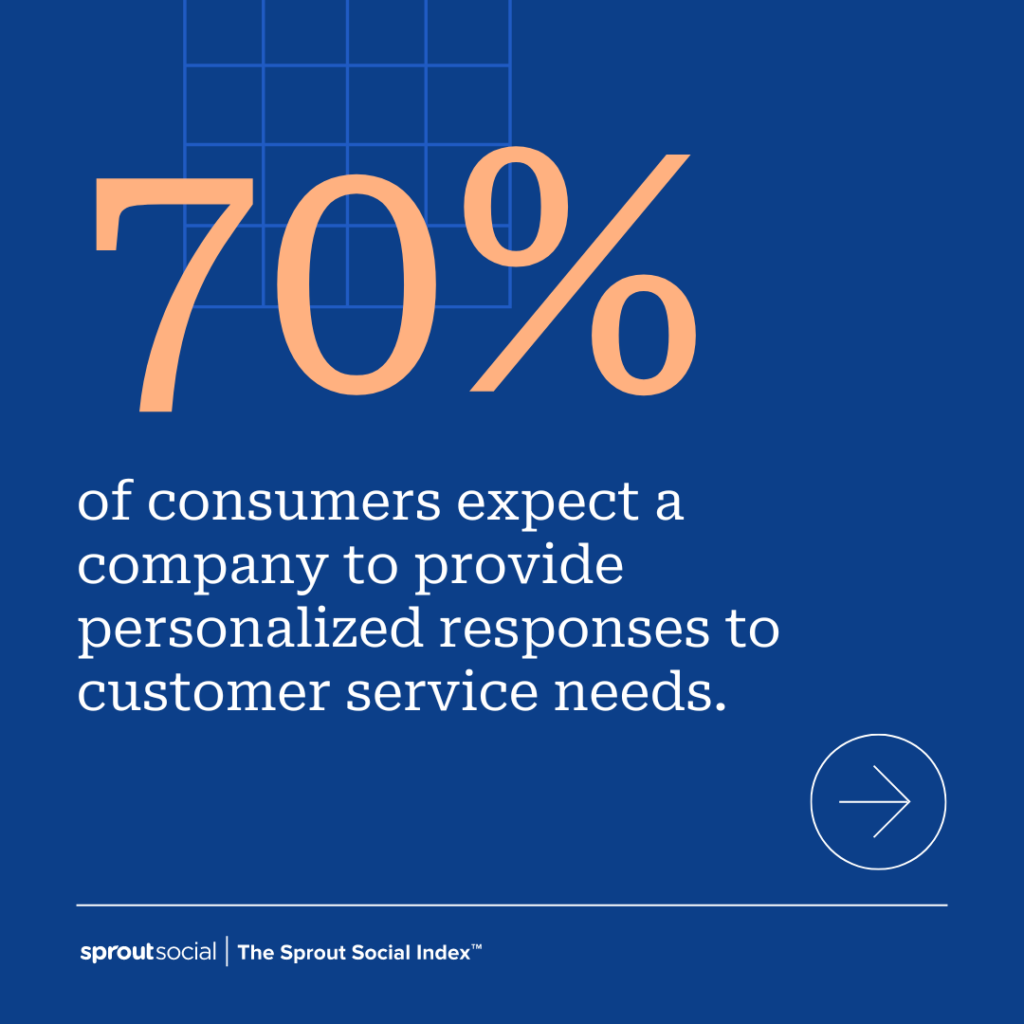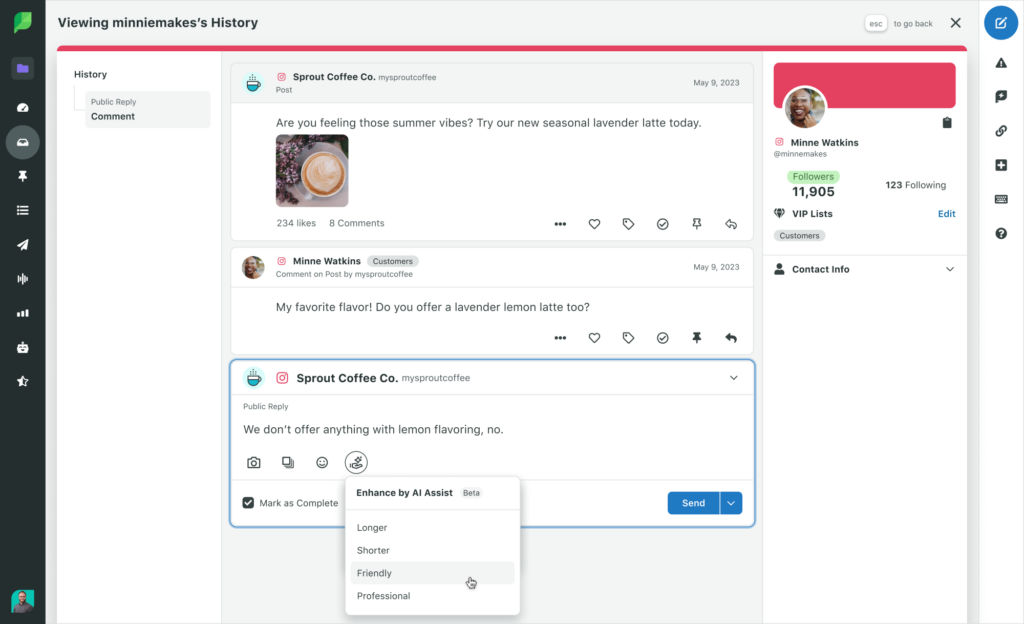Social media managers are time travelers. They need to look to the future to be ready for the shifting forces (*cough* algorithm changes) of social. But at the same time, they must pay attention to current social trends, emerging tech and landscape. And grounding yourself in social media best practices is a great place to start.
To help you get ahead with your social media marketing and maximize your social channels in the coming year, we’ve compiled a list of 16 essential social media best practices for 2024.
- Focus on responsiveness and personalization
- Automate where you can—with a human touch
- Examine your social customer service approach
- Be more business-focused and strategic with sharing your social data
- Leverage AI…and refine how you use it
- Iron out your approval process
- Reimagine your team’s structure and size
- Feature customers and trusted faces on your feed
- Be selective about taking a stand
- Leverage your employees
- Use video…but mix it up
- Redefine your relationship with trends
- Highlight your product in action
- Think platform-first
- Optimize existing platform strategies
- Optimize for social commerce
These best practices for 2024 are grouped below in different key areas for your business, including customer care, bringing authenticity into your strategy and beyond.
Best practices for world-class social customer care
In today’s competitive social landscape, stellar social media customer care is a non-negotiable. Leave it behind in your strategy, and your consumers will leave you behind in the feed.
Here are a few social media marketing best practices for stellar customer care.
1. Focus on responsiveness and personalization to build loyalty
According to The 2023 Sprout Social Index™, 76% of consumers value how quickly a brand can respond to their needs.
But the quality of your responses also matters—70% of consumers expect a company to give them personalized responses.

Ensure your team has the tools they need to shorten your brand’s response times and create more quality responses. A few ways to start:
- Audit your current response time average. A report like Sprout’s Inbox Activity Report will quickly calculate your performance by response rate and percentage.
- Use tools like customer service chatbots to have chat coverage 24/7 for low-lift questions to free up your team.
- Ensure your team is engaging with positive comments to build loyalty, too—not just questions or complaints.

2. Automate where you can—with a human touch
A greater need for personalized, frequent responses means more time for your already-strapped teams. Enter AI and automation.
For example, in 2024 54% of marketers plan to employ customer self-service tools and resources like chatbots, FAQs and other forms to scale social customer care. They also want to use AI copy tools, like ChatGPT or Sprout Social’s Suggestions by AI Assist, as a starting point to generate real-time responses to customer questions and FAQs inside self-service tools.
Just always edit to humanize and stay on-brand—you don’t want to lose trust with consumers who are already wary of brands speaking to them through AI.

3. Examine your social customer service approach
Prioritizing social media customer care is crucial as more people turn to social for their customer support needs. 76% of consumers value how quickly a brand can respond to their needs. Rethink how you approach social customer care, and whether you’re prioritizing it.
The Index also found that 58% of social and marketing teams will either share social customer care in 2024, or customer service will be assisting marketing. If you’re not already collaborating across these teams, it’s time to start. Think: splitting up social monitoring, or working together to create FAQs, canned responses and bot copy.
And scale social customer care by utilizing the right social customer service tools, including AI and automation. A tool like Sprout Social will give you a 360-degree view of your brand’s interactions with your customers—integrating the worlds of social media and customer service.
Redefine how you work and social’s role in your business
Social media insights have impact and implications beyond social—just look at the need to prove social media ROI. And according to the Index, 76% of marketers agree that their team’s insights inform other departments.
But just as social media changes, teams must also change to keep up with the demands put on them. Here are a few tips to bring into your workflow.

4. Be more business-focused and strategic with sharing your social data
According to the Index, social media traffic to the website is a top metric that 60% of marketing strategists, managers and directors track regularly. This is your sign to start tying your social media data to larger business goals.
Turn to your fellow marketers for reference. The Index found that in 2024, most marketers plan on connecting the value of social to business goals by quantifying the value of social media engagement in terms of potential revenue, tracking conversions and sales from social and using social data to inform areas outside of their team.

A few key ways to do this:
- Use UTMs to connect social media posts and strategy directly to website traffic and sales.
- Consider a more sophisticated tool like Sprout’s social listening to uncover deeper data insights that has org-wide uses, including product analysis information, consumer sentiment, competitive share of voice data and beyond.
- Create reports for collaborators outside of the social team to expand social’s impact cross-org. Get started with these 10 social media report examples.
5. Leverage AI…and refine how you use it
The Index found that 81% of marketers say AI has already had a positive impact on their work—especially freeing up time for creativity and boosting efficiency. And the questions around AI have shifted from “will it take my job?” to “will it impact consumer trust?”

As you move into a new phase of the AI era, refine how you use it. Experiment with it for customer care responses, and content ideation and creation. But ensure you’re always editing for brand voice, humanizing the copy and personalizing customer-facing messages.
Apply it: Start using AI for the repetitive tasks you complete regularly, from strategy planning to content creation and data analysis. Try Sprout’s AI Assist technology to see how we can streamline your day-to-day across publishing, engagement, reporting and beyond.
6. Iron out your approval process
Trend cycles move at the speed of light. Which means your approval process must keep up.
If you’re feeling bogged down by a slow approval process, take the initiative to create an optimized workflow for your team and cross-collaborators. Build a seamless social media approval process all drafters and approvers can agree to. It could be the difference between going viral and getting left behind.
Apply it: For best results, use a social media collaboration tool like Sprout Social to formalize your approval process. Sprout’s Approval Workflow also lets you add and remove external stakeholders so they can review social posts before they’re published without needing to log in to Sprout.

7. Reimagine your team’s structure and size
The way you use social data, insights and platforms has evolved. And so too must your team.
We’ll always say that now is a good time to add fresh talent to your team. But it’s not just team size that needs to be rethought—it’s your team structure and how you work. For example, 64% of social teams are organized by network. That is, one team member is responsible for TikTok, one for Instagram, etc. But this approach may not be as effective as it once was as teams share insights beyond social.
Even though social data can inform other departments, 43% of social teams are still feeling siloed. If you can relate, it may be time to see how a new team structure might help. Can a team member focus on engagement, and another awareness? Or can a team member be dedicated to analytics, and another to content creation?
Best practices to bring authenticity into your strategy
There’s a reason why Merriam-Webster’s word-of-the-year in 2023 is “Authentic.”
Between the rise of AI and shaky brand promises in recent years, audiences are wary of inauthentic messaging. In fact, authentic, non-promotional content is the number one thing consumers report not seeing enough of from brands on social, according to The Sprout Social Index™.
Creating authentic content is one of the quintessential best practices for social media. Here are a few ways to do it.
8. Feature customers and trusted faces on your feed
Featuring actual customers and user-generated content on your feed helps build social proof and trust, and bring authentic voices into your content.
Partnering with creators and influencers also adds a trusted voice to your content and extends your reach. In fact, 81% of social marketers describe influencer marketing as an essential part of their social strategy in our Q3 2023 Sprout Pulse Survey.
52% of brands are using dedicated influencer marketing platforms to help offset the challenge of finding the right influencer for their campaigns. If that’s something you’re looking for, consider adopting a platform like Tagger to manage your partnerships.
9. Be selective about taking a stand
Only a quarter of consumers polled in the Index said that the most memorable brands on social speak out about causes and news that align with their values.
Audiences are wary of inauthentic brand statements and promises. Know your values, and take a stand on issues that are aligned with them. Take L.L Bean, for example—they took a social media pause for mental health awareness month because it aligned with their brand values and mission.

10. Leverage your employees
Some of your most influential brand advocates are the people behind your brand: your employees. Adding employee advocacy to your social strategy is one of the most effective ways to amplify your content, humanize your brand and engage your audience.
Launch an employee advocacy program and curate a pipeline of content to ensure long-term success. In a Sprout survey of 1,110 US social media users across industries, over half of engaged social users are most likely to share employee updates. So create a “meet the team” series to showcase your employees.
@sproutsocial At Sprout, our north star means empowering you to drive business impact using our product. Listening to customer feedback is critical for us to do this and provide the resources you need to move your brand forward. We love celebrating when we get it right and looking at ways to be iterating along the way to stay relevant to the current needs of businesses. Our north star drives us, but recognition like this from #G2 and our customers fuels us along the way. We know every decision matters when dealing with evolving market dynamics and fierce competition. Our intuitive platform speedily uncovers insights, helping you define that path forward more clearly. Thank you for letting us know we’re getting it right. ?? #SaaS #CustomerReviews #Fyp #B2B #SocialMediaMarketing #Marketing
? original sound – Sprout Social
Social media best practices for evolving your content
Just as people’s interests and tastes change, so too do the types of social content, preferred formats and trends they follow.
Here are a few social media best practices to evolve your content for optimal engagement.
11. Use video…but mix it up
Video’s popularity is here to stay, at least according to the 66% of consumers who say short-form video is the most engaging in-feed content.
But we’ve also seen a renewed focus on static content in 2023. Even Instagram pared back their focus on video to renew focus on photo posts.
Fill your content calendar with a healthy mix of video, carousels, polls and static photo or graphic-based posts. And pro tip: lighten the video lift by recruiting social video talent from your team and beyond.

12. Redefine your relationship with trends
Using trends is a great way to build awareness. But you don’t have to jump on every single one—that’s inauthentic and unsustainable. According to the Index, 38% of consumers say the most memorable brands on social prioritize original content over trending topics.
Use a healthy mix of on-brand trends and original content, and keep looking at your social analytics to find your top-engaged and most successful formats. If you use Sprout, the Post Performance Report surfaces your top posts across networks by your metric of choice.

13. Highlight your product in action
According to The Sprout Social Index™ 2022, 51% of consumers like to see brands highlighting their product or service in their social posts.
But remember, your product or service shouldn’t be the hero of your posts. Instead, demonstrate how it empowers your target customers to overcome their challenges. With your customers’ use cases in mind, show your product or service in action.
14. Think platform-first
It’s true that you should repurpose posts across social networks to alleviate workload. It’s also true that you need to adjust each post to feel native to each platform.
Approach your content in a platform-first way, so each post you publish fits on the networks you’re posting to.
Here are a few social platform guides and best practices to follow:
15. Optimize existing platform strategies
New platforms are bound to emerge—just look at the recent launch of Threads.
Experimenting with new platforms will always be important. But optimize the content and approach you take on the platforms you use—and that your audiences uses most often.
Here are a few tips:
16. Optimize for social commerce
By 2025, social shopping is set to become a $1.2 trillion channel. And with TikTok recently rolling out TikTok Shop in the US, platforms are continuing to invest in this approach. Social commerce is a great way to sell directly on social.
Have a point of view and use data to back up your decision on where your customers want to buy, and optimize your social commerce tools on platforms where they are ready to go all in.
Whether you set up shop directly in your platforms or link to products in posts, optimizing your social channels for social commerce directly connects your customers and products. Start enhancing your omnichannel customer experience with all-in-one social commerce tools the help reduce friction in the buying process—for example, you can use Sprout’s social commerce solutions to integrate your social and commerce workflows.
Develop your social media best practices this year
Social media is always shifting. Platform shake-ups and new frontiers push social managers to learn new skills, change how their team works, experiment with emerging technologies and refine their approach on a regular basis.
Ground your 2024 strategy—and beyond—in social media best practices to help you weather all the uncertainty. We recommend that you bookmark this list so you can revisit it when you need help optimizing your social efforts.
To put these best practices for social media in action, we also recommend using a tool that supports all of them—from finding your best posting times, to auditing your content. Begin your free Sprout trial today, and transform every area of your organization and team.
Start your free Sprout trial